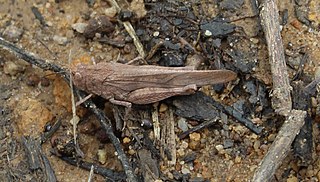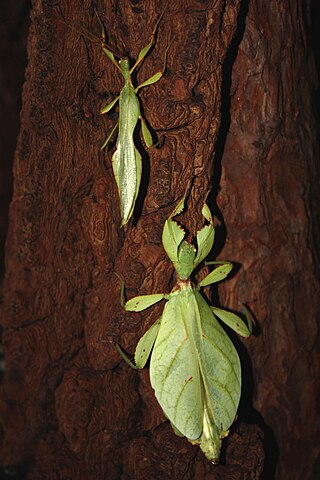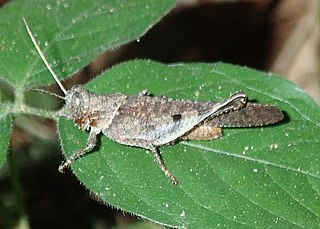
The African rice grasshopper, Hieroglyphus daganensis is a medium-sized grasshopper species found in the Sahel region. Although not called a locust in English, this species shows gregarious behaviour and some morphological change on crowding and may become a moderately important pest species for small-holder farmers in the region.

Anacridium moestum, the camouflaged tree locust, is a species of grasshopper belonging to the family Acrididae, that is native to Africa south of the equator. It is similar in appearance to the Southern African desert locust, Schistocerca gregaria flavicentris. It is likewise brownish, large and slender, but mostly arboreal in its habits.

The Tanaoceridae are an insect family in the monotypic superfamily Tanaoceroidea in the suborder Caelifera. They are sometimes called desert long-horned grasshoppers.

Valanga is a genus of "bird grasshoppers" in the subfamily Cyrtacanthacridinae. Species are found from the Indian subcontinent through southeast Asia and the Korean peninsula to Australia and the Pacific islands.

The Ommexechidae are a family of grasshoppers, in the Orthoptera: suborder Caelifera. Species in this family can be found in the Americas.
The Tristiridae are a family of grasshoppers, in the Orthoptera: suborder Caelifera. Species in this family can be found in the Americas.
Praxibulus is a genus of grasshoppers found in Australia.

Kosciuscola is a genus of grasshoppers in the subfamily Oxyinae. They are found in Australia.

Monistria is a genus of grasshoppers in the family Pyrgomorphidae and the tribe Monistriini. Species are found Australia, New Zealand and surrounding islands.

The Heteropterygidae is a family of stick insects belonging to the suborder Euphasmatodea. Species can be found in Australasia, East and Southeast Asia. About 150 valid species have been described.

Phyllium jacobsoni is a hybrid species of yellow/green leaf insect belonging to the family Phylliidae. Its recorded distribution is Java and no subspecies are listed in the Catalogue of Life.

Gryllotalpa unispina is a species of mole cricket, in the G. gryllotalpa species group, found in Eastern Europe through to Manchuria. No subspecies are listed in the Catalogue of Life.

Erucius is a genus of "monkey grasshoppers" in the family Chorotypidae. Species in this genus can be found in Vietnam and Malesia, including the Philippines. It is the only genus in the subfamily Eruciinae.
Fruhstorferiola is a genus of grasshoppers, subfamily Melanoplinae, tribe Podismini Jacobson, 1905 and subtribe Tonkinacridina Ito, 2015; the type species was identified from Vietnam, but a majority of species are found only in China.
Gelastorhinus is a genus of grasshoppers in the subfamily Gomphocerinae. Species have been recorded from tropical Africa and Asia.

Epistaurus is a genus of grasshoppers in the family Acrididae, subfamily Coptacrinae.
Hemigyrus is an Asian genus of bush-crickets in the tribe Phyllomimini and the subfamily Pseudophyllinae. Species have been recorded from: southern China and Indo-China.
Isopsera is an Asian genus of bush crickets in the subfamily Phaneropterinae. Species can be found in India, Indochina, Malesia and the Pacific Islands.
Coptotettix is an Asian genus of ground-hoppers in the subfamily Tetriginae.

Schistocerca pallens is a large “bird grasshopper” in the subfamily Cyrtacanthacridinae that occurs throughout tropical America. It is closely related to Schistocerca cancellata but shows no swarming behaviour or locust phase polymorphism, even under crowded laboratory conditions. Although not a swarming locust, it can occur at sufficiently high densities to cause economic damage. It is mainly a pest of sugar cane, but has also been recorded as damaging almond, banana, beans, breadfruit, carnauba wax palm, chickpeas, coconut palms, cotton, forage crops, groundnuts, indigo, legumes, maize, onions, rice, sorghum, sweet potato and tomatoes.












